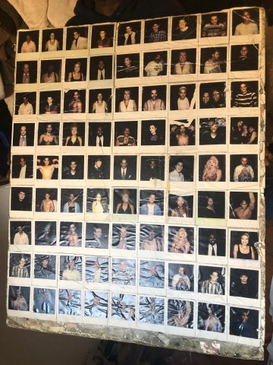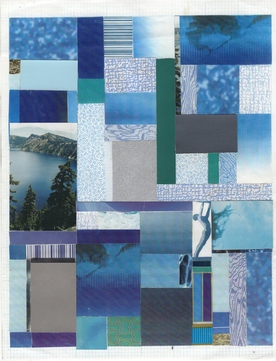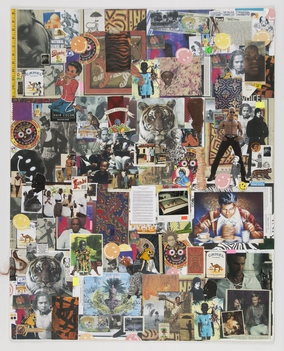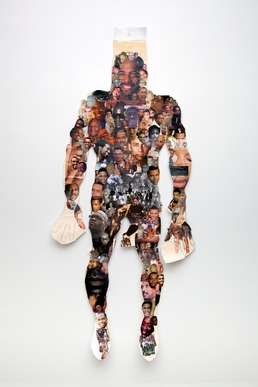Frederick Weston facts for kids
Quick facts for kids
Frederick Weston
|
|
|---|---|
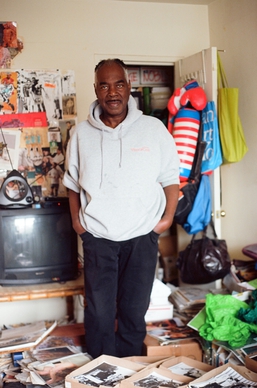
Weston in his apartment/studio, 2020
|
|
| Born |
Frederick Eugene Weston
December 9, 1946 |
| Died | October 21, 2020 (aged 73) |
| Nationality | American |
| Known for | Artist |
Frederick Weston (1946–2020) was an American artist who worked in many different ways. He taught himself how to create art. He made collages, drawings, sculptures, and took photos. He also did performances and wrote creatively.
Weston grew up in Detroit, Michigan. He moved to New York City in the mid-1970s. In the mid-1990s, he helped start a group called Underground Railroad. This group created art on the streets and in outdoor places. For most of his life, his art was shown to small groups in unusual art spaces. Only in his last two years did his work become widely known and liked in city art groups.
In 1995, Weston was diagnosed with AIDS. He had always wanted to write about fashion. Later, a therapist helping people with AIDS encouraged him to write poems about his feelings. People who reviewed his art later saw his poetry in his collages. In 2019, the Foundation for Contemporary Arts gave him an award. They praised his collages as "visual poetry." They said his art explored being an individual and how communities shape who we are. A curator also wrote that Weston used collage because it was a quick way to make "tactile poetry."
Weston was humble about becoming famous later in life. In an interview in 2019, he said he was getting recognition because he was 73. He also mentioned that he had lived with AIDS for a long time and had kept making art.
Early Life and Education
Frederick Eugene Weston was born on September 9, 1946, in Memphis, Tennessee. His mother, Freda Morman Weston, was 21 and not married. When he was a baby, Freda took him to live with her parents, Fred and Emma Weston, in Detroit. His grandfather, Fred, worked in a car factory. His grandmother, Emma, was a homemaker. Weston later said his grandparents were his main caregivers. He called them "mother" and "daddy." He called his own mother "Freda."
Weston grew up in a home where people loved to read and create. He was read to often and loved reading himself. His mother was a great seamstress. She made beautiful women's clothes. Weston went to integrated public schools in Detroit. This was because of policies that ended segregation. He said he felt comfortable there and got a good education. He worked hard at odd jobs to earn money. This helped him go to and graduate from Ferris University. He liked being a student there. He even helped start the university's first African-American fraternity.
Weston learned to make clothes by watching his mother sew. He designed clothes for himself. He also worked at an all-Black modeling agency in Detroit. In 1971, he earned a degree in marketing from Ferris State University.
In 1973, Weston moved to Manhattan. He couldn't find work in the fashion world. So, he took low-paying jobs that paid cash. In the early 1980s, he started studying at the Fashion Institute of Technology. He took classes in menswear design and marketing. He graduated with honors in 1985. He worked for a short time with designer Stephen Burrows. But he became frustrated with unfair practices in the fashion industry. He gave up his dream of becoming a fashion writer.
During the 1980s, he kept working low-paying jobs. He checked hats and coats at gay bars in Manhattan. All this time, he collected and organized materials for the collages he had started to make. He later said he had never learned to draw. But by the mid-1990s, some unexpected events made him believe he could become a professional artist.
In March 1995, Weston learned he had AIDS. A friend sent him to Gay Men's Health Crisis. This was an organization that helped people with AIDS. Someone there suggested he join the AIDS Adult Day Health Care Program. This program was run by Village Care of New York. Weston was accepted into the program. He started getting health services and food. This helped him eat two meals a day instead of just one. He also got help with financial aid. Most importantly, he was encouraged and given supplies to make art projects.
In 1998, Weston brought photos taken by a friend who had passed away to Visual AIDS. This group supports artists who have AIDS. They saw his artistic talent. They invited him to join and show his work in their exhibitions.
Art Career
Around the time he joined the AIDS Adult Day Health Care Program, Weston took a night job at a gay bar. He took photos of young gay men he met there. He dressed them in outfits he put together. Weston displayed these photos on the wall of his coat-check area. This was called his first solo art show. In 1996, the club moved. Weston kept working there and created his second solo show, "Night Blooming Flowers."
In the late 1990s, Weston worked at a clothing store. He was asked to design a blue-themed display for the front of the store. He gathered many empty containers he had collected. He painted them all blue. He arranged them to look like an abstract city scene. The shop owner didn't like his idea. So, he put his project on the sidewalk in front of a blue construction barrier nearby. This was the first version of one of his most famous works, "Blue Bathroom Blues." He got the title from poems he had written. The project changed over time. It went from outdoor displays of empty containers to collages made of small pieces of paper.
During this time, Weston kept showing his collages in unusual places. These included Village Care, Stella's, the AIDS Housing Network Art Gallery, and the Lesbian, Gay, Bisexual and Transgender Community Center.
In 2000, Weston showed a collage called "Little Black Sambo" at Village Care. Like "Blue Bathroom Blues," this project changed over the years. One version from 2006, "Sambo Schema I," is shown here. The Sambo character in the children's book is a person of color from South India. Weston felt that many people with dark skin were wrongly called "African-American." He said, "I don't know what I am. But I'm not African." He knew the Sambo story was seen as racist. But he saw it differently. He said it was about using your wits to survive when you are in danger.
In 2003, Weston showed collages in a group show called "Release." It was organized by Visual AIDS. In 2011, he had a special exhibition of his past works. It was called "For Colored Boys Who Have Considered *** When All You Ever Needed Was the Blues." It was held at Ferris State University.
Later that year, his work was in a group show called "Stay, Stay, Stay." Three years later, he showed his art with another group at Davidson College. He also showed his collages in four group shows in 2017. These included "Intersectional Identities," "Found: Queer Archaeology; Queer Abstraction," "AIDS at Home," and "Cut Here." In 2018, he often appeared in group shows and discussions. He frequently showed slides of his art.
In 2019, Gordon Robichaux gallery had a solo show of Weston's work called "Happening." This show included a recent version of his "Body Map" project. He started this collage in 2013. It was made from images and small paper objects he had collected for 30 years. He organized them in binders by topics like race, gender, and color. "Body Map I" from 2015, shown here, includes pictures of important African-American men.
In 2020, Weston received a $40,000 award, the Roy Lichtenstein Award. That year, he also showed "Blue Bedroom Blues" at an art fair in New York. He appeared in group shows in Los Angeles as well.
Artistic Style
Weston used binders to organize the materials for his collages. He often used photocopiers to copy images he liked. He once said, "I multiply. I know I'm a multiplier... I love the copy machine." His sources included things he called "trash." He also used ads and media pictures about AIDS, human bodies, and queer topics. Men's fashion was very important to him. In 2020, he told an interviewer, "My whole practice really is about the way that men look, men comport themselves, and the way that men pose." A reviewer in 2019 said that fashion was a "pleasurable, expressive place of liberation" for Weston. It was a place where ideas about race, gender, and class could mix.
Personal Life
Weston was a friendly and outgoing person. He stayed close with his family, friends from Detroit, and his fraternity brothers. While living in New York, he faced financial difficulties. He also went through tough emotional times. These problems often led him to move from one small hotel room to another. Sometimes, his struggles caused him to lose his belongings.
Weston's habit of collecting materials for his collages could become very strong. He joined a group called Clutterers Anonymous to help him manage this problem.
Weston passed away on October 21, 2020. Earlier that year, he found out he had advanced bladder cancer. This was the cause of his death. An obituary said he worried that treating the cancer might affect his HIV medications. So, he decided not to seek more hospital treatment. He stayed home and focused on his art.
Images for kids


